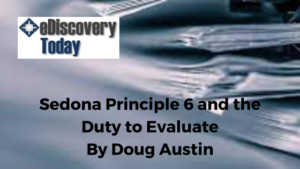
On eDiscovery Today, I engaged in a follow up discussion on my TAR series (published in two parts here and here and republished in one part here) with Dr. Jeremy Pickens, Principal Data Scientist at OpenText, who is friend and well-respected colleague (many of us call him “Dr. J.”). Dr. J is perhaps eDiscovery Today’s most prolific commenter – probably in number and certain in size of comments – and I learn a lot from him regularly through his informative comments on my blog posts.
The discussion became focused on my reference to Sedona Principle 6 (which is one of the 14 principles discussed in the excellent guide The Sedona Principles, go to page 53 of the PDF to see the entire list of principles), which states:
Responding parties are best situated to evaluate the procedures, methodologies, and technologies appropriate for preserving and producing their own electronically stored information.
The Sedona Principles, page 53
Sedona Principle 6 was referenced by Judge Andrew Peck (ret.) in Hyles v. New York City where he ruled the defendant didn’t have to use TAR because of Sedona Principle 6 (despite being a strong advocate of TAR approaches).
Dr. J. asked whether the defendant’s evaluation was referenced in the ruling and I pointed out that the ruling stated:
The City declined, both because of cost and concerns that the parties, based on their history of scope negotiations, would not be able to collaborate to develop the seed set for a TAR process…At the conference, even after the Court’s ruling on the custodians and date range largely accepted the City’s scope parameters, the City still declined to agree to use TAR.
Judge Andrew Peck (ret.) Hyles v. New York City
Dr. J. responded by saying:
Ah, here we have it. A non-intentional reveal that evaluation was NOT done. Why? Because I know — having done multiple publicly-published experiments from 2012-2016 in which I examine the effect of starting with different seed sets under a TAR 2.0 (CAL) regimen — that variations in the seed set doesn’t matter. Start however you like, even with a single seed, and TAR 2.0 will get you to an efficient (high precision) endpoint (high target recall).
If the Principle 6 evaluation had been done, they would have known this. But because they think that seed sets are something that need to be endlessly discussed and fought over, this tells me that they didn’t actually do the evaluation.
Dr. Jeremy Pickens, Principal Data Scientist at OpenText
That begs the question: What is the duty to evaluate under Sedona Principle 6?
I think there are two levels of duty. One level of duty is what the Court expects. The second level of duty taps into an attorney’s duty of competence. Let’s briefly look at each.
Duty to the Court
While Sedona Principle 6 states that “Responding parties are best situated to evaluate”, I don’t think there is any expectation as to what that evaluation comprises. There’s no standard to adhere to, no expectation of being efficient. Unless the effectiveness and completeness of the “procedures, methodologies, and technologies” in responding to discovery requests are brought into question by the receiving party, the Court isn’t going to care how the responding party got there. If you just considered it from a Court perspective, Sedona Principle 6 would almost be better stated this way (changes bolded):
“Responding parties are best situated to choose the procedures, methodologies, and technologies they feel are appropriate for preserving and producing their own electronically stored information.”
If the responding party doesn’t provide an effective or complete production, the duty falls to the receiving party to call them out on their production deficiencies, per Sedona Principle 7:
“The requesting party has the burden on a motion to compel to show that the responding party’s steps to preserve and produce relevant electronically stored information were inadequate.
Sedona Principle 7
But if the responding party doesn’t provide a deficient production, it doesn’t matter how they got there. Not from the Court’s perspective.
Duty of Competence
However, there is another duty for lawyers (which includes both in-house and outside counsel) – the ethical duty of competence, which is formalized in Rule 1.1: Competence from the ABA Model Rules of Professional Conduct (with technology competence spelled out in Comment 8 to Rule 1.1 (emphasis added):
[8] To maintain the requisite knowledge and skill, a lawyer should keep abreast of changes in the law and its practice, including the benefits and risks associated with relevant technology, engage in continuing study and education and comply with all continuing legal education requirements to which the lawyer is subject.
ABA Model Rules of Professional Conduct Rule 1.1: Competence (emphasis added)
With the duty of competence including the understanding of the benefits and risks of technology, I think lawyers have a duty to evaluate “procedures, methodologies, and technologies” to not only “get the job done”, but also to do it as efficiently and effectively as possible. In my opinion, their duty of technology competence requires them to evaluate (from a level of understanding) all available “procedures, methodologies, and technologies” and select the one best suited for the case. Merely “getting the job done” isn’t enough if it’s done inefficiently. What’s “appropriate” is the approach that is both effective (i.e., getting the job done) and efficient (i.e., doing it cost-effectively).
If parties truly evaluated “procedures, methodologies, and technologies”, a lot more of them would consider using TAR in their cases. Should they? Absolutely! Will courts expect them to? Nope. And it’s not their job to expect them to consider it – it’s the attorney’s job to consider it as part of their duty of competence.
Experience more of Doug Austin’s great work at the eDiscovery Today blog here.
Follow Doug Austin on JD Supra here.
Follow EDRM on JD Supra here.


